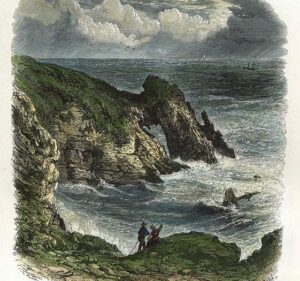Not far from Torquay Harbour is Daddyhole Plain, a limestone plateau 75 metres above the sea. Nearby is the natural arch of London Bridge. Unlike London Bridge, which was named probably in the mid eighteenth century, the name Daddyhole is far more ancient – Daddy being an old English name for the Devil.
 According to local legend the Devil lived in a cave at the bottom of the cliff. This cave was formed when a slab of limestone fell into the sea creating the Devil’s Hole or Daddyhole. There are many Devil’s Holes across Europe and the United States, and they often acquired a reputation for uncanny occurrences, as in the Torquay example.
According to local legend the Devil lived in a cave at the bottom of the cliff. This cave was formed when a slab of limestone fell into the sea creating the Devil’s Hole or Daddyhole. There are many Devil’s Holes across Europe and the United States, and they often acquired a reputation for uncanny occurrences, as in the Torquay example.
We know about our supernatural Daddyhole thanks to an anonymous female author in the middle of the nineteenth century.
 During the early 1800s, Torquay was developing at a rapid pace, being transformed from a small fishing village to an upmarket seaside resort. The Victorians were intrigued by the occult and so the author of the 1850 book ‘Legends of Torquay’ set off to recover folk tales of the area before they were swept away by modernity.
During the early 1800s, Torquay was developing at a rapid pace, being transformed from a small fishing village to an upmarket seaside resort. The Victorians were intrigued by the occult and so the author of the 1850 book ‘Legends of Torquay’ set off to recover folk tales of the area before they were swept away by modernity.
One of the legends supposedly told to the writer was of the ‘Demon Hunter of Daddyhole Plain’.
 The focus of the story was Matilda, “a proud and beautiful maiden who dwelt in the valley yonder”. Matilda was in love, but the object of her affections loved another and she took the news badly.
The focus of the story was Matilda, “a proud and beautiful maiden who dwelt in the valley yonder”. Matilda was in love, but the object of her affections loved another and she took the news badly.
As she walked on the Daddyhole cliffs at night in the misery of unrequited love, Matilda was confronted by “two savage hounds with eyes of fire”. Following was the Devil on a horse – referred to in the story as the Demon Hunter. Apparently, “The arch enemy of man had chosen Daddyhole Plain as a favourite hunting ground” and local villagers were familiar with the unearthly cries of his demon hounds at night.
 On seeing the demonic trio Matilda promptly fainted but woke in the company of a strange and handsome man. She asked him if he had seen the Demon Hunter. He replied, “No. I come hither to bewail alone the grief of disappointed hope, and found you, fair maiden, lying senseless on the ground.”
On seeing the demonic trio Matilda promptly fainted but woke in the company of a strange and handsome man. She asked him if he had seen the Demon Hunter. He replied, “No. I come hither to bewail alone the grief of disappointed hope, and found you, fair maiden, lying senseless on the ground.”
Having apparently rapidly moved on from seeing the Hellhounds and their master, Matilda told the stranger of her rejection. He comforted her with the words, “You have been made to suffer much. Revenge is sweet.” Clearly not being familiar with Christian tradition, and seemingly not noticing that the stranger already knew her name, she unwisely replies, “Revenge! I would barter my soul for to be revenged.”
Matilda and her new friend went on to meet on many nights and Matilda came to love him, but remained filled with resentment for being rejected. With the stranger’s encouragement, Matilda ambushes the man who spurned her and stabs both him and his lover to death as the sun set over Daddyhole, crying, “Mine! Mine for ever!”
 At this point in the tale, the stranger reappears and carries Matilda over the cliff edge on his satanic steed, never to be seen again. You can, however, still hear Matilda crying above the sound of waves breaking against the cliffs at the dead hours of the night. The legend doesn’t say who the witnesses were to these events, or who wrote them down for our moral instruction and entertainment.
At this point in the tale, the stranger reappears and carries Matilda over the cliff edge on his satanic steed, never to be seen again. You can, however, still hear Matilda crying above the sound of waves breaking against the cliffs at the dead hours of the night. The legend doesn’t say who the witnesses were to these events, or who wrote them down for our moral instruction and entertainment.
Such stories of Devil’s pacts were common from the Middle Ages up to the seventeenth century – giving us some idea of the original date of the story. The idea of a deal with the Devil first appears in the 5th century, in the writings of St. Jerome. And in the 6th century the story of Theophilus tells of a man who becomes the Devil’s servant and signs a formal pact. Perhaps the best-known tale is the story of Faust, a scientist and alchemist who sells his soul to the demon Mephistopheles in exchange for lust and youth.
Typically, however, the victim was an ordinary person vulnerable to temptation. The Devil would appear, sometimes as a man and sometimes as an animal, and offers to help. The person gives his or her soul in exchange for diabolical favours. In Matilda’s case, however, she seems to have done the evil deed herself without much supernatural assistance and pretty much nothing in return.
The bargain is always a dangerous one, with eternal damnation for the foolhardy debtor. The Devil would collect, the victim would die and his or her soul would go to Hell. These stories were widely publicised through pamphlets and portrayed the Devil as a trickster. They were also highly moral tales and used to reinforce social stability and order. In Matilda’s story, the message was a warning against jealousy and revenge.
 The appearance of Hellhounds at the Devil’s side is also part of a tradition. Throughout European mythology, dogs have been associated with death and are often the guardians of the underworld. These Hellhounds were described as large animals with glowing eyes and they haunted lonely paces such as gallows sites, crossroads, and ancient pathways – such a link may be due to the scavenging habits of dogs. Accordingly, it shouldn’t be a surprise that they turn up on a windswept plateau in this local legend.
The appearance of Hellhounds at the Devil’s side is also part of a tradition. Throughout European mythology, dogs have been associated with death and are often the guardians of the underworld. These Hellhounds were described as large animals with glowing eyes and they haunted lonely paces such as gallows sites, crossroads, and ancient pathways – such a link may be due to the scavenging habits of dogs. Accordingly, it shouldn’t be a surprise that they turn up on a windswept plateau in this local legend.
So that’s the story of the Demon Hunter of Daddyhole Plain.
 On the other hand, there’s a further possibility.
On the other hand, there’s a further possibility.
A wily local could have just made up some or part of the story. Indeed, it may be more than coincidence that the hugely popular 1796 Gothic novel ‘The Monk: A Romance’ by Matthew Gregory Lewis also has a character called Matilda. This Matilda was similarly a beautiful young woman. She possesses magical powers given to her by the Devil in exchange for her soul, and also loves a man who no longer cares for her.
It isn’t unknown for rural folk to embroider or invent suitable stories to fit the expectations of potentially generous middle class researchers. Another suggestion is that smugglers would invent or spread such tales to keep the curious away from the cliffs at night while they carried on their profession uninterrupted.
 But let’s give the original storyteller the benefit of the doubt. And so, the next time you find yourself late at night at the edge of the Daddyhole cliffs, listen very carefully. You may be able to hear Matilda’s wails amidst the howls of the Demon Hunter’s hounds…
But let’s give the original storyteller the benefit of the doubt. And so, the next time you find yourself late at night at the edge of the Daddyhole cliffs, listen very carefully. You may be able to hear Matilda’s wails amidst the howls of the Demon Hunter’s hounds…


























